Charles E W Bean, Diaries, AWM38 3DRL 606/274/1 - 1918 - 1941 - Part 10
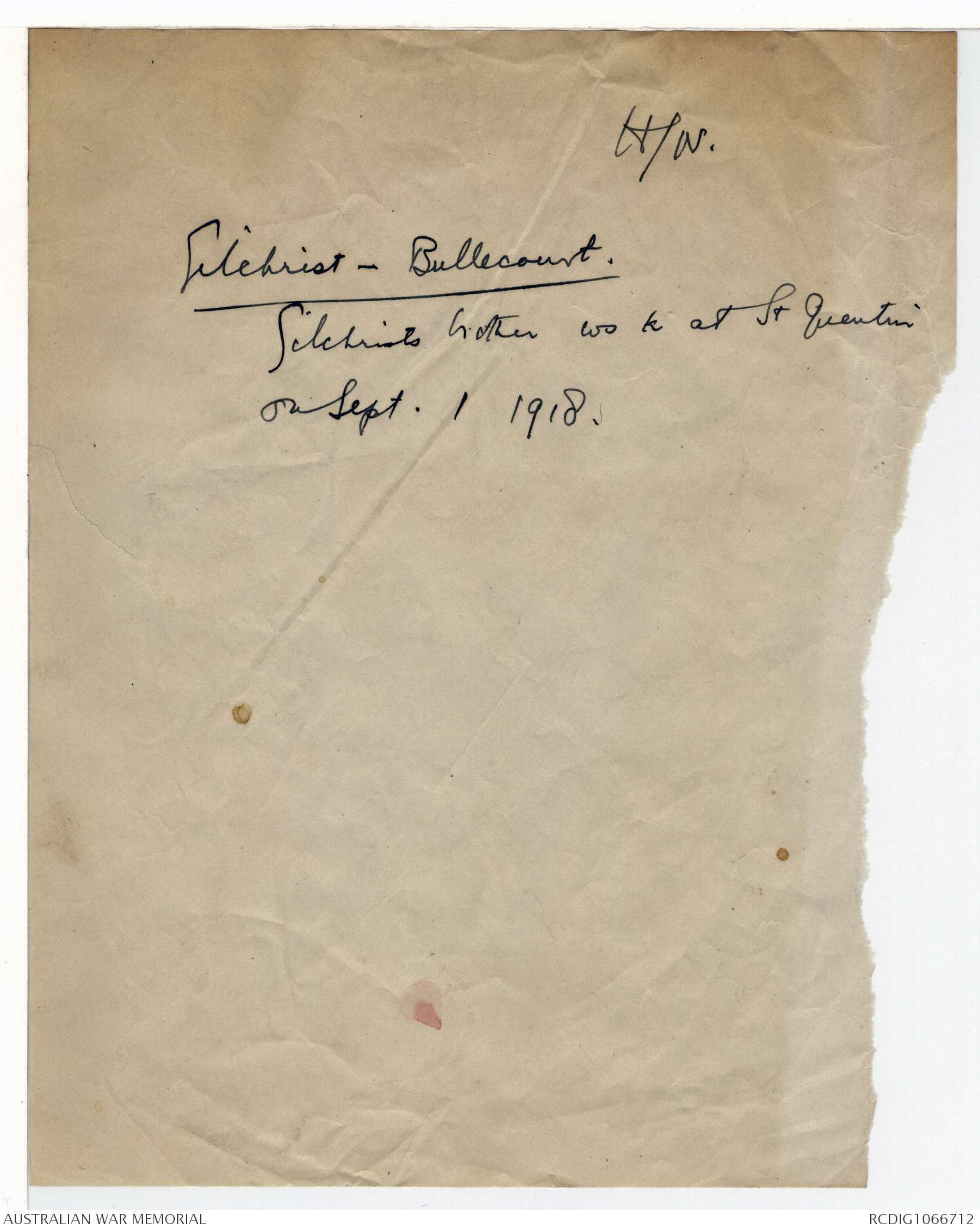
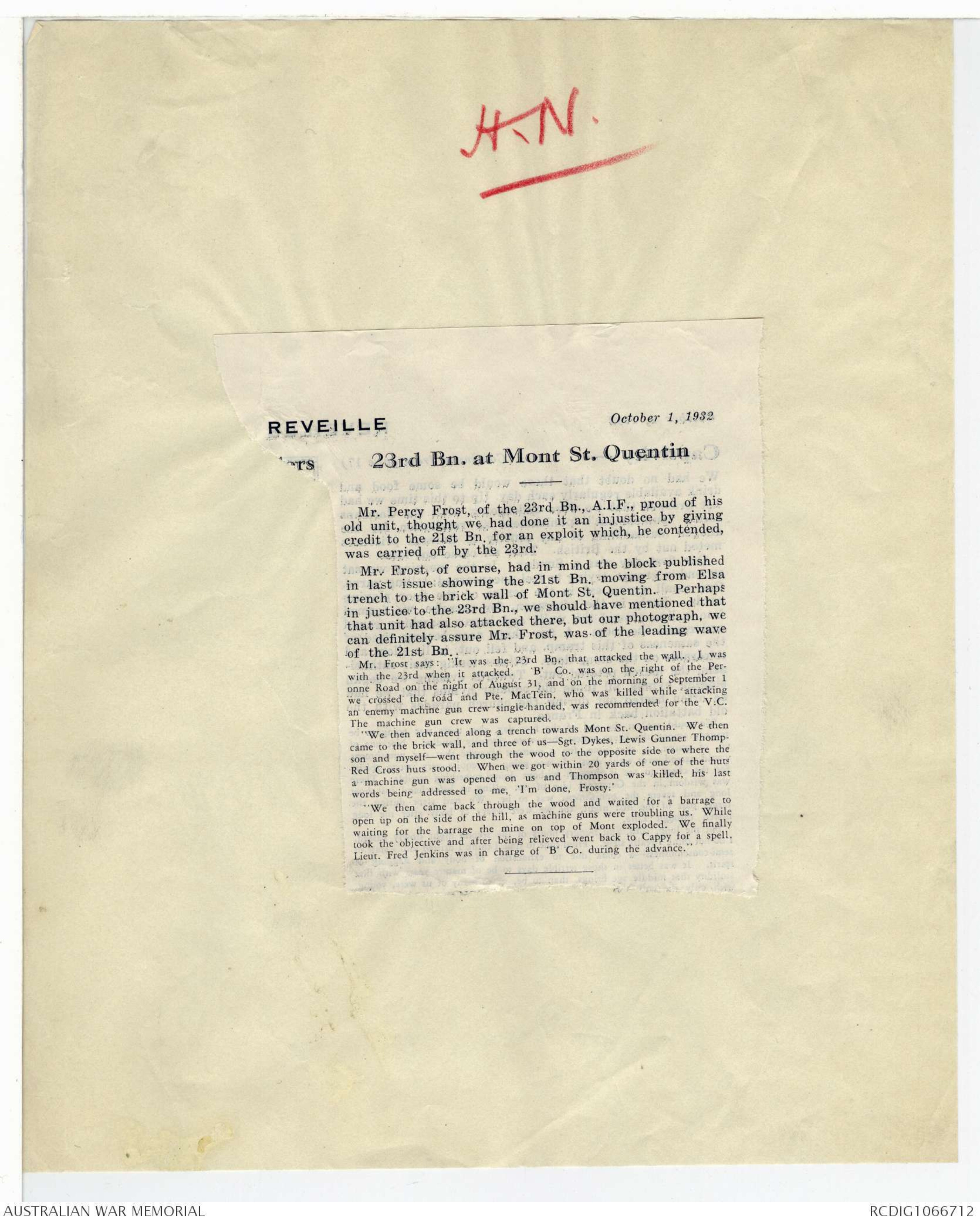

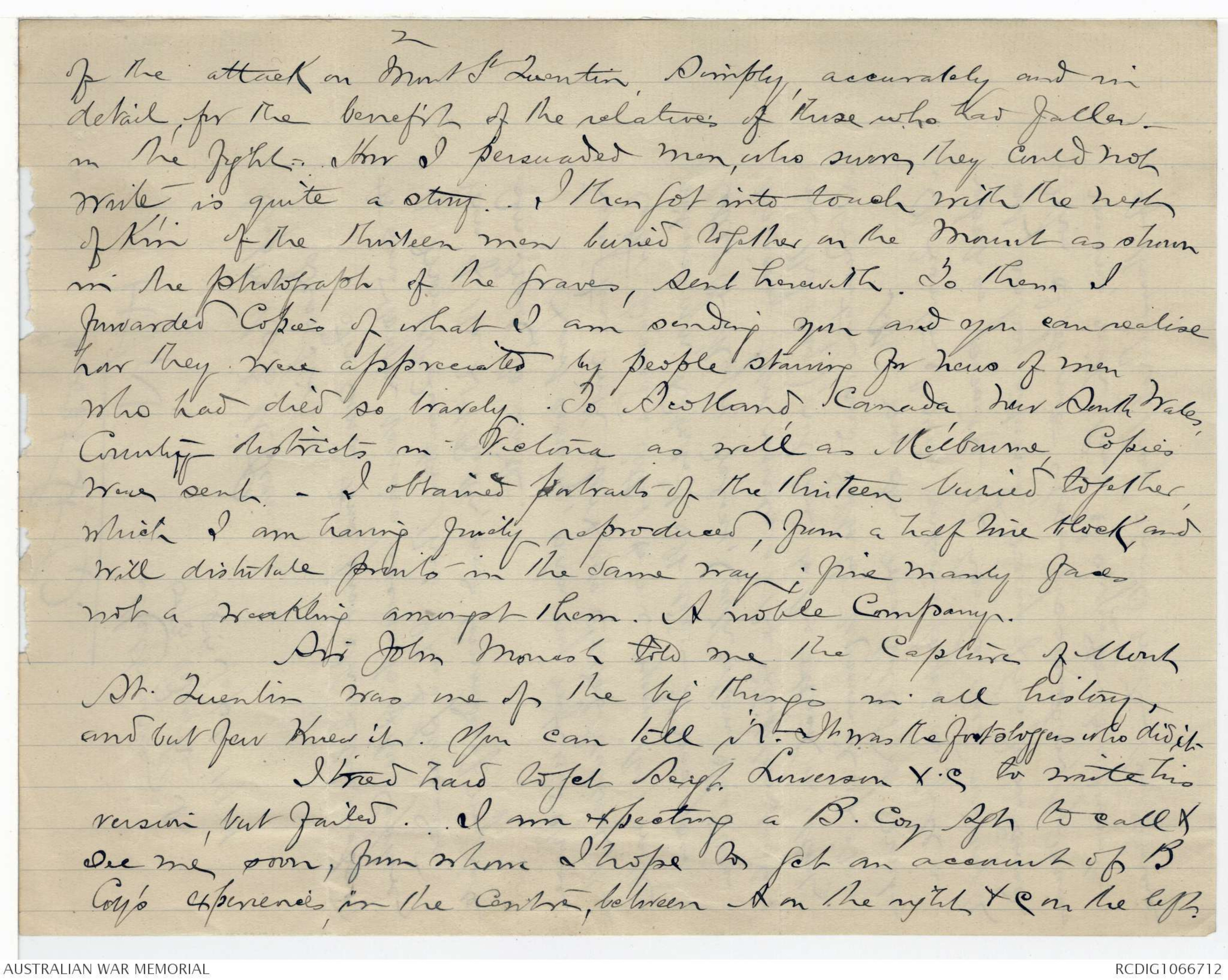
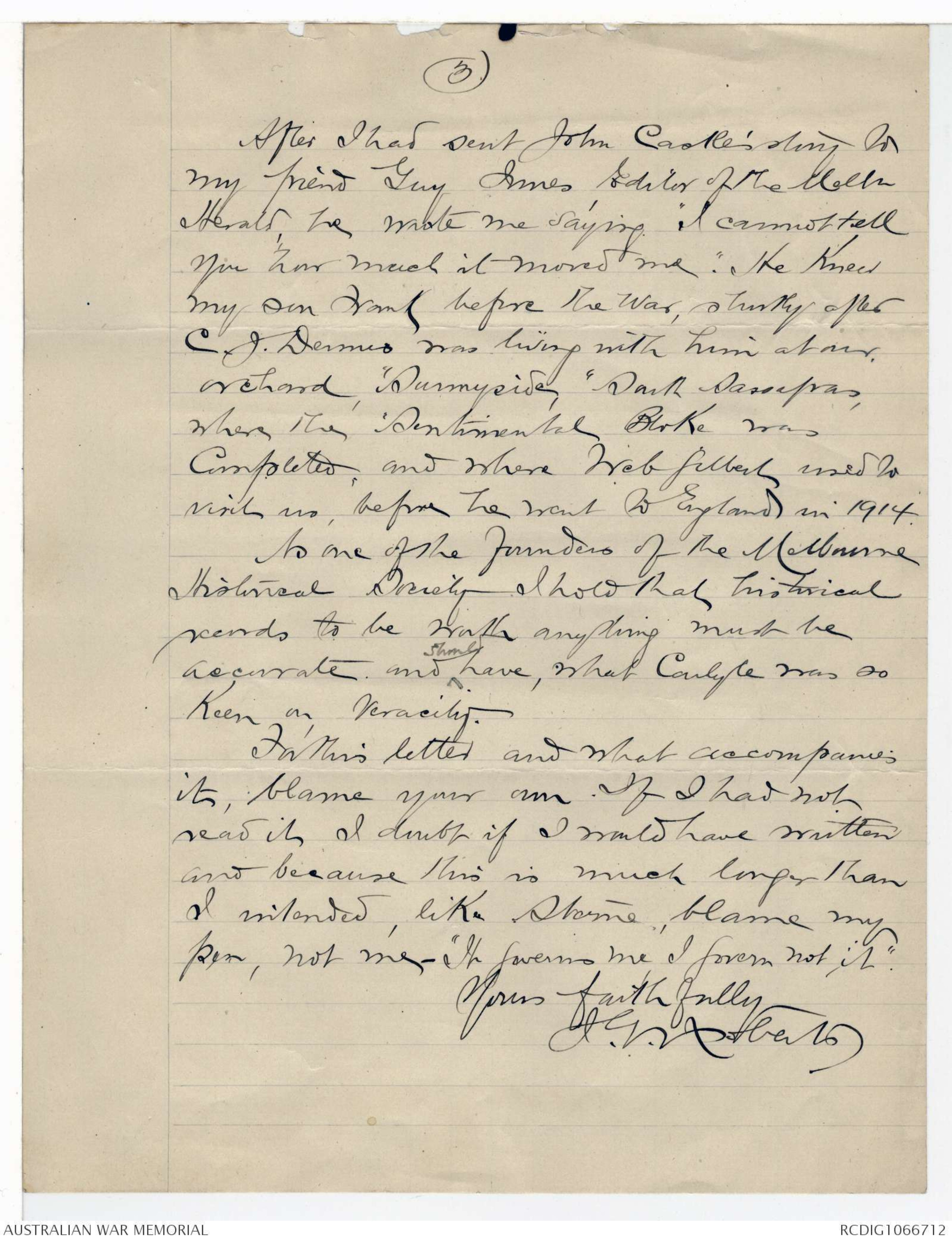
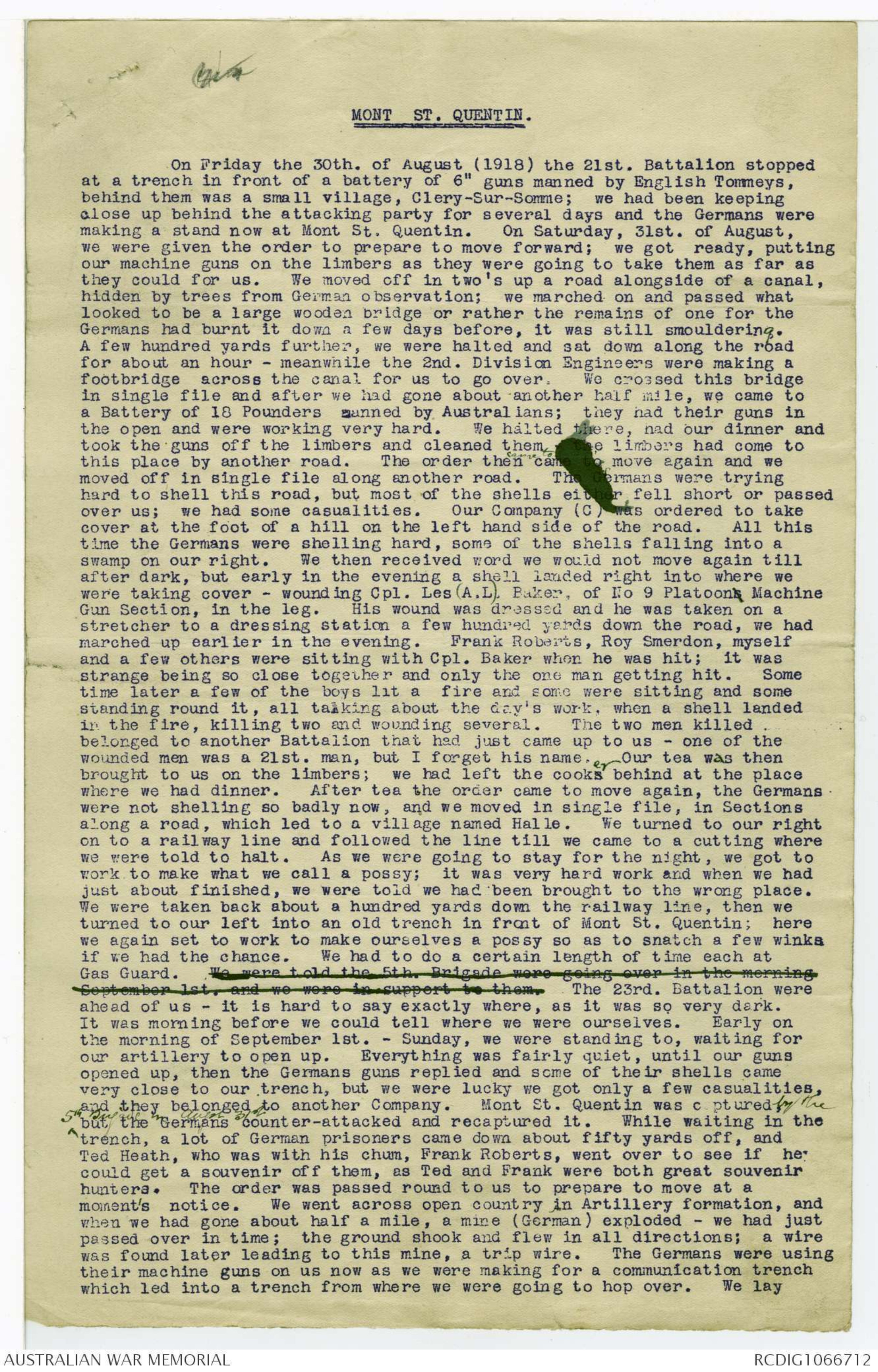
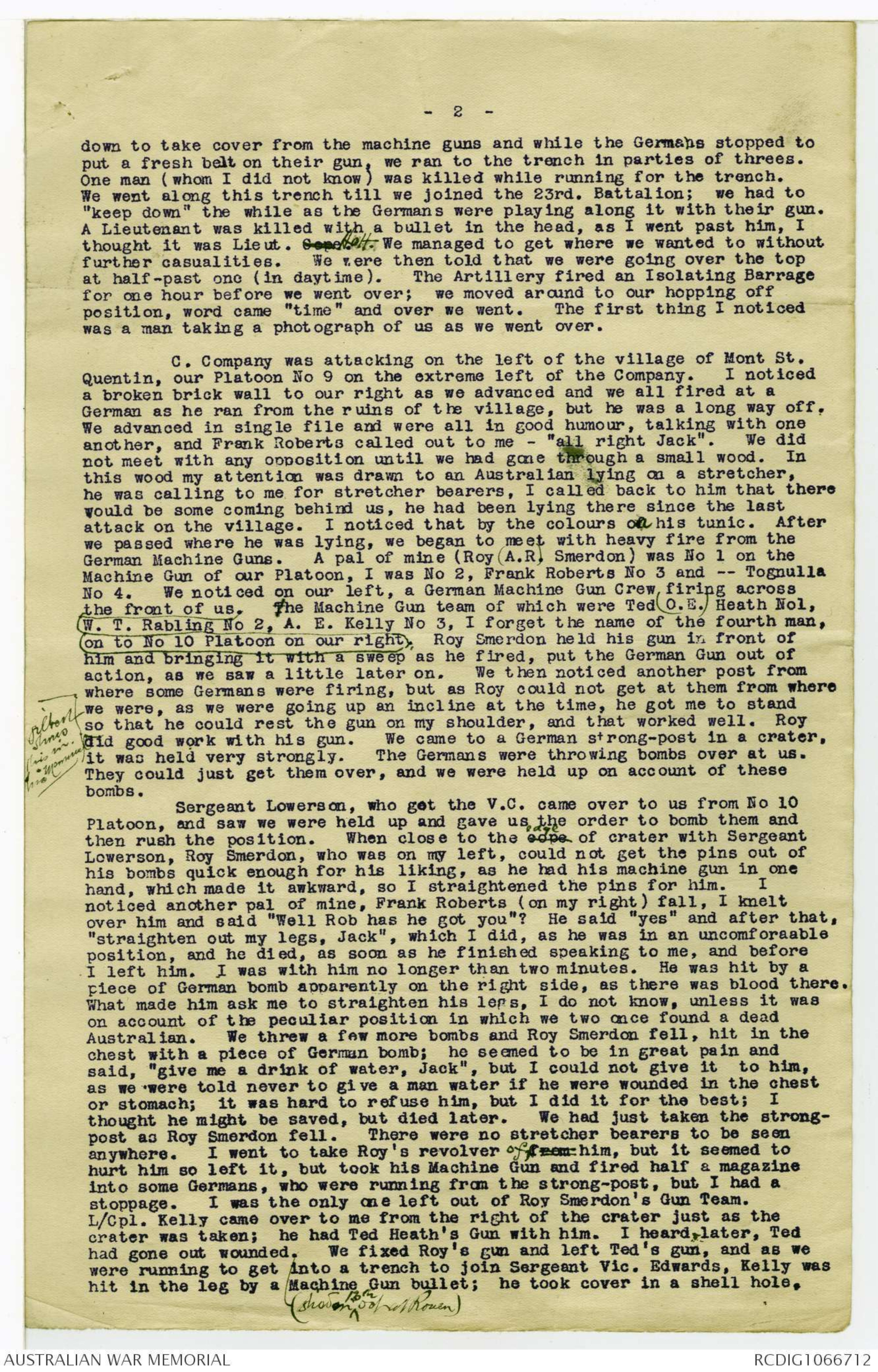
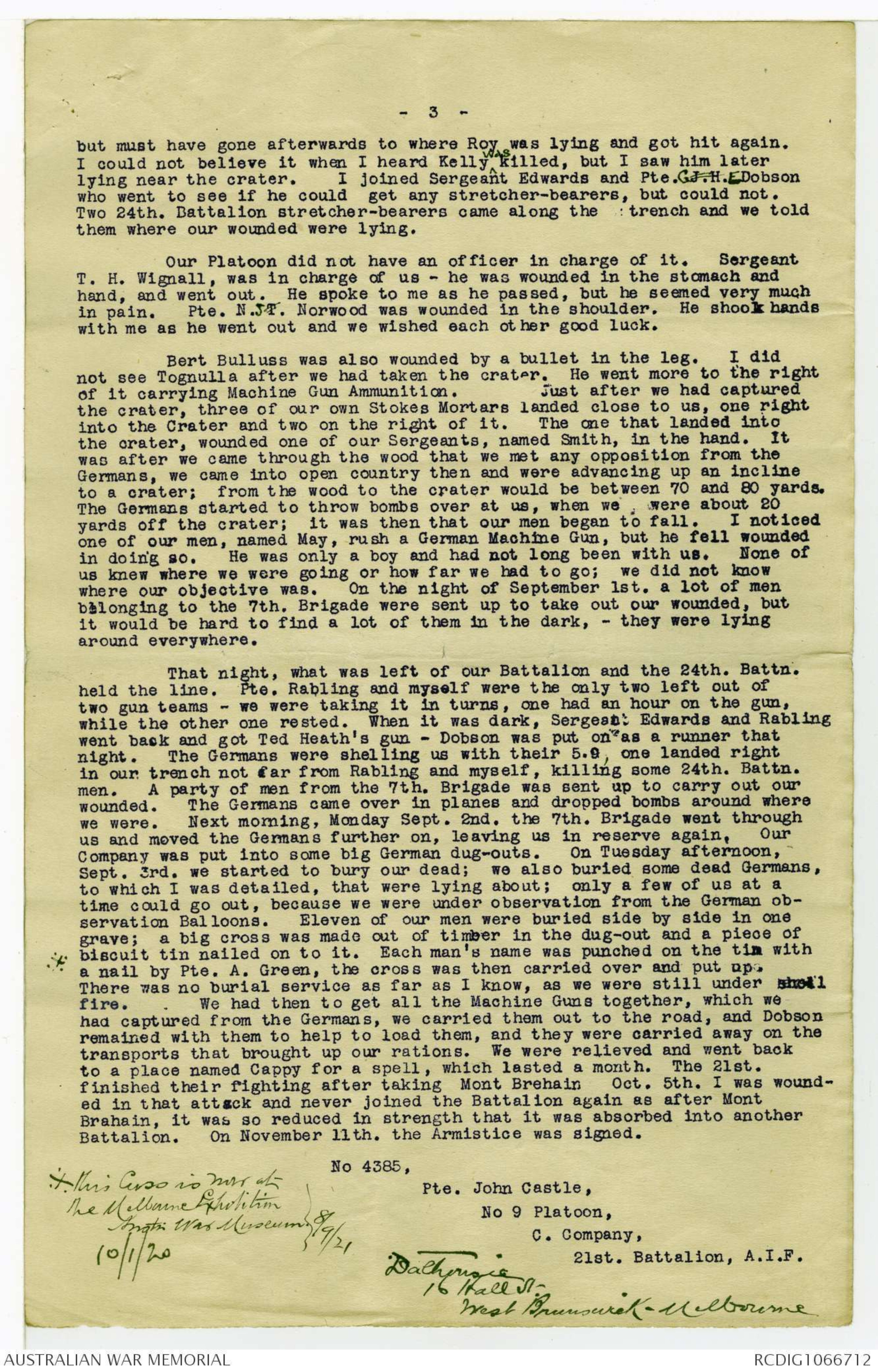
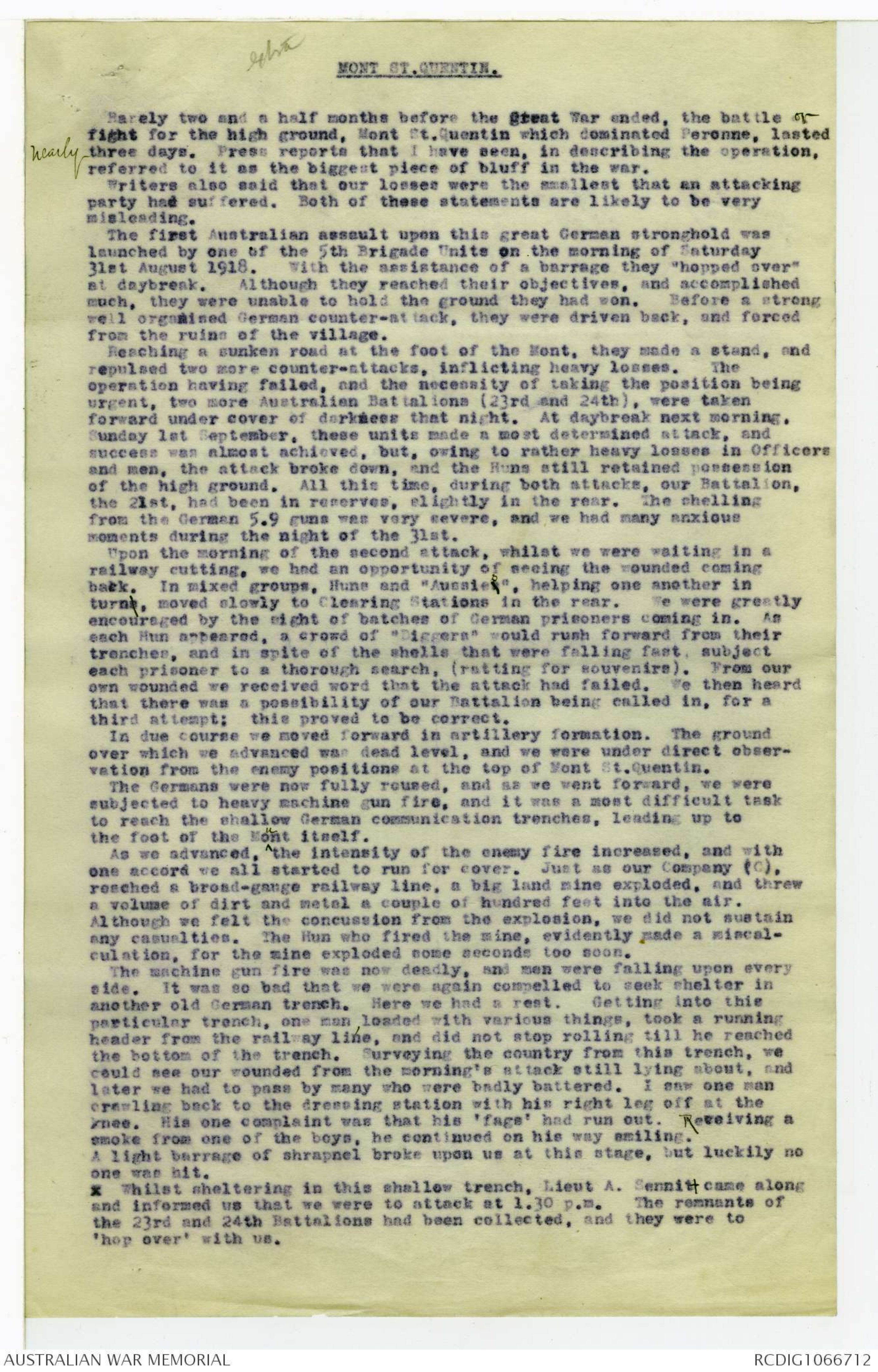
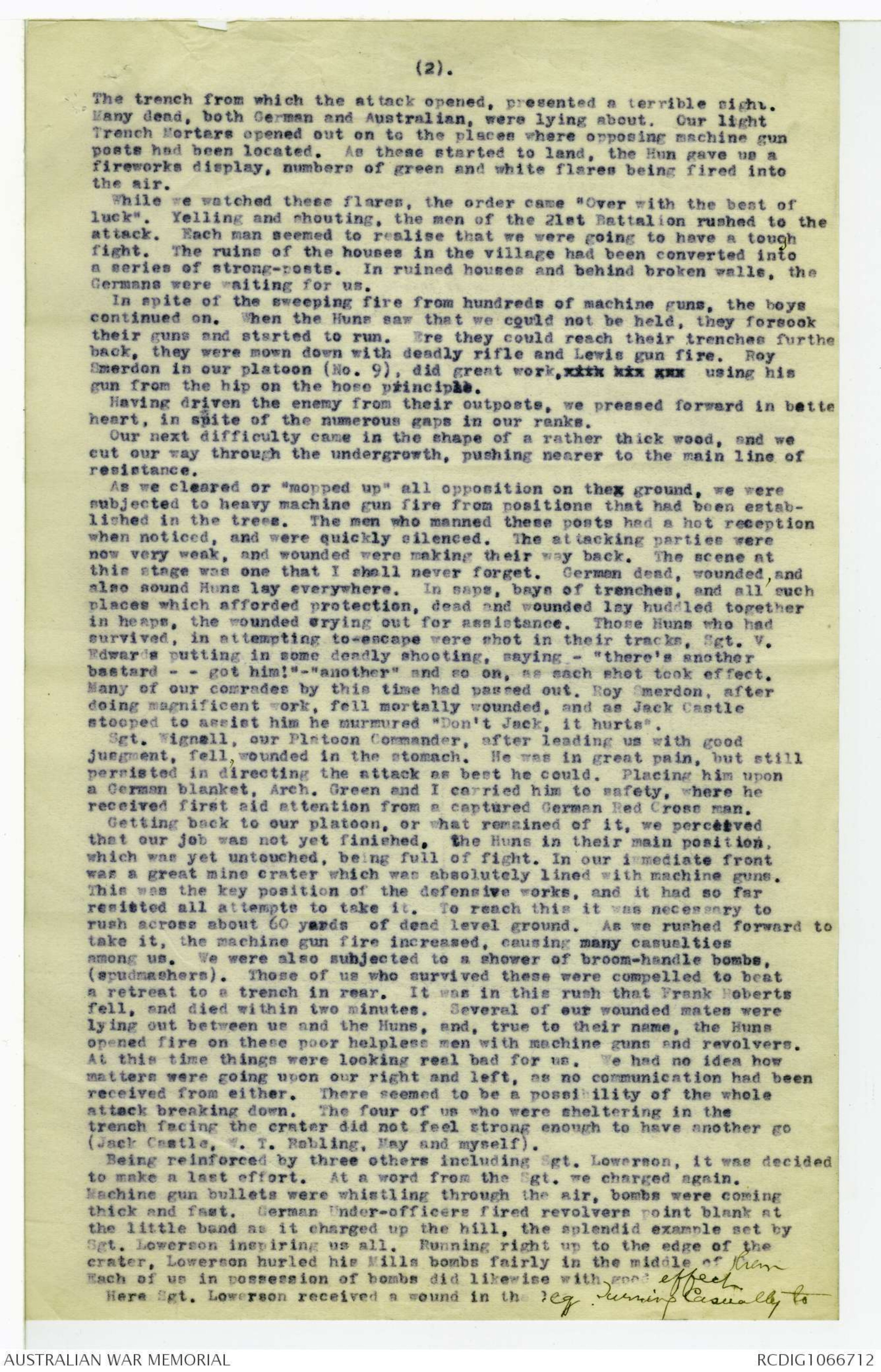
H/N.
Gilchrist - Bullecourt.
Gilchrists brother ws k at St Quentin
on Sept. 1 1918.
H.N.
REVEILLE October 1, 1932
23rd Bn. at Mont St. Quentin
Mr. Percy Frost, of the 23rd Bn., A.I.F., proud of his
old unit, thought we had done it an injustice by giving
credit to the 21st Bn. for an exploit which, he contended,
was carried off by the 23rd.
Mr. Frost, of course, had in mind the block published
in last issue showing the 21st Bn. moving from Elsa
trench to the brick wall of Mont St. Quentin. Perhaps
in justice to the 23rd Bn., we should have mentioned that
that unit had also attacked there, but our photograph, we
can definitely assure Mr. Frost, was of the leading wave
of the 21st Bn.
Mr. Frost says: "It was the 23rd Bn. that attacked the wall. I was
with the 23rd when it attacked. 'B' Co. was on the right of the Peronne
Road on the night of August 31, and on the morning of September 1
we crossed the road and Pte. MacTein, who was killed while attacking
an enemy machine gun crew single-handed, was recommended for the V.C.
The machine gun crew was captured.
"We then advanced along a trench towards Mont St. Quentin. We then
came to the brick wall, and three of us - Sgt. Dykes, Lewis Gunner Thompson
and myself - went through the wood to the opposite side to where the
Red Cross huts stood. When we got within 20 yards of one of the huts
a machine gun was opened on us and Thompson was killed, his last
words being addressed to me, 'I'm done, Frosty.'
"We then came back through the wood and waited for a barrage to
open up on the side of the hill, as machine guns were troubling us. While
waiting for the barrage the mine on top of Mont exploded. We finally
took the objective and after being relieved went back to Cappy for a spell.
Lieut. Fred Jenkins was in charge of 'B' Co. during the advance,"
Mont St Q.
H/N.
Melbourne
673 Bourke St
8th Sept. 1921
Captn C.E.W. Bean.
Dear Sir.
For some time past I have been disposed
to send to you various accounts of the capture
of Mont St Quentin that I had persuaded
men of the 21st Battn, and comrades of my late
Son Frank to write.
Last evening, when my wife and I were
having tea with Mr & Mrs Caleb Gilbeth, the
latter passed a letter to me saying, "This will
interest you, Robert."! It did :- it was your
letter to Major Treloar, (with whom I had been
discussing War records at the Exhibition earlier
in the day), relative to the attack on Mont
St Quentin and Gilbert's memorial of it.
After my son was killed at Mont
St Quentin, I was anxious to get as full a
report as possible of how he died and sought
out as they returned, many of his former comrades.
When I got into closer association, by various
means, with them I suggested to a number
of them that they should write their experiences
2
of the attack on Mont St Quentin. Simply, accurately and in
detail, for the benefit of the relatives of those who had fallen-
in the fight. How I persuaded men, who swore they could not
write is quite a story ... I then got into touch with the next
of kin of the thirteen men buried together on the Mount as shown
in the photograph of the graves, sent herewith. So then I
forwarded copies of what I am sending you and you can realise
how they were appreciated by people starving for news of men
who had died so bravely. To Scotland, Canada, New South Wales,
Country districts in Victoria as well as Melbourne, Copies
were sent - I obtained portraits of the thirteen buried together,
which I am having [[quickly?]] reproduced, from a half line block, and
will distribute prints in the same way; fine manly lads
not a weakling amongst them. A noble Company.
Sir John Monash told me the Capture of Mont
St Quentin was one of the big things in all history,
and but few knew it. You can tell it. It was the first staffers who did it.
I tried hard to get Sergt. Leverson V.C. to write his
version, but failed.. I am expecting a B. Coy Sgt to call &
see me soon, from where I hope to get an account of B
Coy's experiences, in the centre, between A on the right & C on the left.
3
After I had sent John Castle's story to
my friend Guy Innes, Editor of the Melbn
Herald, he wrote me saying "I cannot tell
you how much it moved me." He knew
my son Frank before the War, shortly after
C.J. Dennis was living with him at our
orchard, "Sunnyside," South Sassafras,
where the "Sentimental Bloke was
completed, and where Web Gilbert used to
visit us, before he went to England in 1914.
As one of the founders of the Melbourne
Historical Society I hold that historical
records to be worth anything must be
accurate and ^should have, what Carlyle was so
keen on, veracity.
For this letter and what accompanies
it, blame your own. If I had not
read it I doubt if I would have written
and because this is much longer than
I intended, like Sterne, blame my
pen, not me - "It governs me I govern not it."
Yours faithfully
J.G.Roberts
MONT ST. QUENTIN.
On Friday the 30th. of August (1918) the 21st. battalion stopped
at a trench in front of a battery of 6" guns manned by English Tommeys,
behind them was a small village, Clery-Sur-Somme; we had been keeping
close up behind the attacking party for several days and the Germans were
making a stand now at Mont St. Quentin. On Saturday, 31st. of August,
we were given the order to prepare to move forward; we got ready, putting
our machine guns on the limbers as they were going to take them as far as
they could for us. We moved off in two's up a road alongside of a canal,
hidden by trees from German observation; we marched on and passed what
looked to be a large wooden bridge or rather the remains of one for the
Germans had burnt it down a few days before, it was still smouldering.
A few hundred yards further, we were halted and sat down along the road
for about an hour - meanwhile the 2nd. Division Engineers were making a
footbridge across the canal for us to go over. We crossed this bridge
in single file and after we had gone about another half mile, we came to
a Battery of 18 Pounders manned by Australians; they had their guns in
the open and were working very hard. We halted there, had our dinner and
took the guns off the limbers and cleaned them, the limbers had come to
this place by another road. The order then came to move gain and we
moved off in single file along another road. The Germans were trying
hard to shell this road, but most of the shells either fell short or passed
over us; we had some casualities. Our Company (C) was ordered to take
cover at the foot of a hill on the left hand side of the road. All this
time the Germans were shelling hard, some of the shells falling into a
swamp on our right. We then received word we would not move again till
after dark, but early in the evening a shell landed right into where we
were taking cover - wounding Cpl. Les (A.L). Baker, of No 9 Platoons Machine
Gun Section, in the leg. His wound was dressed and he was taken on a
stretcher to a dressing station a few hundred yards down the road, we had
marched up earlier in the evening. Frank Roberts, Roy Smerdon, myself
and a few others were sitting with Cpl. Baker when he was hit; it was
strange being so close together and only the one man getting hit. Some
time later a few of the boys lit a fire and some were sitting and some
standing round it, all talking about the day's work, when a shell landed
in the fire, killing two and wounding several. The two men killed
belonged to another Battalion that had just come up to us - one of the
wounded men was a 21st. man, but I forget his name. Our tea was then
brought to us on the limbers; we had left the cookser behind at the place
where we had dinner. After tea the order came to move again, the Germans
were not shelling so badly now, and we moved in single file, in Sections
along a road, which led to a village named Halle. We turned to our right
on to a railway line and followed the line till we came to a cutting where
we were told to halt. As we were going to stay for the night, we got to
work to make what we call a possy; it was very hard work and when we had
just about finished, we were told we had been brought to the wrong place.
We were taken back about a hundred yards down the railway line, then we
turned to our left into an old trench in front of Mont St. Quentin; here
we again set to work to make ourselves a possy so as to snatch a few winks
if we had the chance. We had to do a certain length of time each at
Gas Guard. We were told the 5th. Brigade were going over in the morning
September 1st. and we were in support to them. The 23rd. Battalion were
ahead of us - it is hard to say exactly where, as it was so very dark.
It was morning before we could tell where we were ourselves. Early on
the morning of September 1st. - Sunday, we were standing to, waiting for
our artillery to open up. Everything was fairly quiet, until our guns
opened up, then the Germans guns replied and some of their shells came
very close to our trench, but we were lucky we got only a few casualities,
and they belonged to another Company. Mont St. Quentin was captured by the
^5th Brigade on Augst 31st but the Germans counter-attacked and recaptured it. While waiting in the
trench, a lot of German prisoners came down about fifty yards off, and
Ted Heath, who was with his chum, Frank Roberts, went over to see if he
could get a souvenir off them, as Ted and Frank were both great souvenir
hunters. The order was passed round to us to prepare to move at a
moment's notice. We went across open country in Artillery formation, and
when we had gone about half a mile, a mine (German) exploded - we had just
passed over in time; the ground shook and flew in all directions; a wire
was found later leading to this mine, a trip wire. The Germans were using
their machine guns on us now as we were making for a communication trench
which led into a trench from where we were going to hop over. We lay
- 2 -
down to take cover from the machine guns and while the Germans stopped to
put a fresh belt on their gun, we ran to the trench in parties of threes.
One man (whom I did not know) was killed while running for the trench.
We went along this trench till we joined the 23rd. Battalion; we had to
"keep down" the while as the Germans were playing along it with their gun.
A Lieutenant was killed with a bullet in the head, as I went past him, I
thought it was Lieut. Cope Holt. We managed to get to where we wanted to without
further casualities. We were then told that we were going over the top
at half-past one (in daytime). The Artillery fired an Isolating Barrage
for one hour before we went over; we moved around to our hopping off
position, word came "time" and over we went. The first thing I noticed
was a man taking a photograph of us as we went over.
C. Company was attacking on the left of the village of Mont St.
Quentin, our Platoon No 9 on the extreme left of the Company. I noticed
a broken brick wall to our right as we advanced and we all fired at a
German as he ran from the ruins of the village, but he was a long way off.
We advanced in single file and were all in good humour, talking with one
another, and Frank Roberts called out to me - "all right Jack". We did
not meet with any opposition until we had gone through a small wood. In
this wood my attention was drawn to an Australian lying on a stretcher,
he was calling to me for stretcher bearers, I called back to him that there
would be some coming behind us, he had been lying there since the last
attack on the village. I noticed that by the colours on his tunic. After
we passed where he was lying, we began to meet with heavy fire from the
German Machine Guns. A pal of mine (Roy (A.R.) Smerdon) was No 1 on the
Machine Gun of our Platoon, I was No 2, Frank Roberts No 3 and -- Tognulla
No 4. We noticed on our left, a German Machine Gun Crew firing across
the front of us on to No 10 Platoon on our right.. The Machine Gun team of which were Ted (O.E.) Heath No 1,
W. T. Rabling No 2, A. E. Kelly No 3, I forget the name of the fourth man,
Roy Smerdon held his gun in front of
[*Gilbert shares this in his memoirs*]
him and bringing it with a sweep as he fired, put the German Gun out of
action, as we saw a little later on. We then noticed another post from
where some Germans were firing, but as Roy could not get at them from where
we were, as we were going up an incline at the time, he got me to stand
so that he could rest the gun on my shoulder, and that worked well. Roy
did good work with his gun. We came to a German strong-post in a crater,
it was held very strongly. The Germans were throwing bombs over at us.
They could just get them over, and we were held on account of these
bombs.
Sergeant Lowerson, who got the V.C. came over to us from No 10
Platoon, and saw we were held up and gave us the order to bomb them and
then rush the position. When close to the cope edge of crater with Sergeant
Lowerson, Roy Smerdon, who was on my left, could not get the pins out of
his bombs quick enough for his liking, as he had his machine gun in one
hand, which made it awkward, so I straightened the pins for him. I
noticed another pal of mine, Frank Roberts (on my right) fall, I knelt
over him and said "Well Rob has got you"? he said "yes" and after that,
"straighten out my legs, Jack", which I did, as he was in an uncomfortable
position, and he died, as soon as he finished speaking to me, and before
I left him. I was with him no longer than two minutes. He was hit by a
piece of German bomb apparently on the right side, as there was blood there.
What made him ask me to straighten his legs, I do not know, unless it was
on account of the peculiar position in which we two once found a dead
Australian. We threw a few more bombs and Roy Smerdon fell, hit in the
chest with a piece of German bomb; he seemed to be in great pain and
said, "give me a drink of water, Jack", but I could not give it to him,
as we were told never to give a man water if he were wounded in the chest
or stomach; it was hard to refuse him, but I did it for the best; I
thought he might be saved, but died later. We had just taken the strong-post
as Roy Smerdon fell. There were no stretcher bearers to be seen
anywhere. I went to take Roy's revolver off from him, but it seemed to
hurt him so left it, but took his Machine Gun and fired half a magazine
into some Germans, who were running from the strong-post, but I had a
stoppage. I was the only one left out of Roy Smerdon's Gun Team.
L/Cpl. Kelly came over to me from the right of the crater just as the
crater was taken; he had Ted Heath's Gun with him. I heard, later, Ted
had gone out wounded. We fixed Roy's gun and left Ted's gun, and as we
were running to get into a trench to join Sergeant Vic. Edwards, Kelly was
hit in the leg by a Machine Gun bullet; he took cover in a shell hole.
[[?(shot on ^13th ? Rouen?)]]
- 3 -
but must have gone afterwards to where Roy was lying and got hit again.
I could not believe it when I heard Kelly ^was killed, but I saw him later
lying near the crater. I joined Sergeant Edwards and Pte. G. G.H. E Dobson
who went to see if he could get any stretcher-bearers, but could not.
Two 24th. battalion stretcher-bearers came along the trench and we told
them where our wounded were lying.
Our Platoon did not have an officer in charge of it. Sergeant
T. H. Wignall, was in charge of us - he was wounded in the stomach and
hand, and went out. He spoke to me as he passed, but he seemed very much
in pain. Pte. N.J. T. Norwood was wounded in the shoulder. He shook hands
with me as he went out and we wished each other good luck.
Bert Bulluss was also wounded by a bullet in the leg. I did
not see Tognulla after we had taken the crater. He went more to the right
of it carrying Machine Gun Ammunition. Just after we had captured
the crater, three of our own Stokes Mortars landed close to us, one right
into the Crater and two on the right of it. The one that landed into
the crater, wounded one of our Sergeants, named Smith, in the hand. It
was after we came through the wood that we met any opposition from the
Germans, we came into open country then and were advancing up an incline
to a crater; from the wood to the crater would be between 70 and 80 yards.
The Germans started to throw bombs over at us, when we were about 20
yards off the crater; it was then that our men began to fall. I noticed
one of our men, named May, rush a German Machine Gun, but he fell wounded
in doing so. He was only a boy and had not long been with us. None of
us knew where we were going or how far we had to go; we did not know
where our objective was. On the night of September 1st. a lot of men
belonging to the 7th. Brigade were sent up to take out our wounded, but
it would be hard to find a lot of them in the dark, - they were lying
around everywhere.
That night, what was left of our Battalion and the 24th. Battn.
held the line. Pte. Rabling and myself were the only two left out of
two gun teams - we were taking it in turns, one had an hour on the gun,
while the other one rested. When it was dark, Sergeant Edwards and Rabling
went back and got Ted Heath's gun - Dobson was put on as a runner that
night. The Germans were shelling us with their 5.9, one landed right
in our trench not far from Rabling and myself, killing some 24th. Battn.
men. A party of men from the 7th. Brigade was sent up to carry out our
wounded. The Germans came over in planes and dropped bombs around where
we were. Next morning, Monday Sept. 2nd. the 7th. Brigade went through
us and moved the Germans further on, leaving us in reserve again. Our
Company was put into some big German dug-outs. On Tuesday afternoon,
Sept. 3rd. we started to bury our dead; we also buried some dead Germans,
to which I was detailed, that were lying about; only a few of us at a
time could go out, because we were under observation from the German observation Balloons. Eleven of our men were buried side by side in one
grave; a big cross was made out of timber in the dug-out and a piece of
[*※*] biscuit tin nailed on to it. Each man's name was punched on the tin with
a nail by Pte. A. Green, the cross was then carried over and put up.
There was no burial service as far as I know, as we were still under shell
fire. We had then to get all the Machine Guns together, which we
had captured from the Germans, we carried them out to the road, and Dobson
remained with them to help load them, and they were carried away on the
transports that brought up our rations. We were relieved and went back
to a place named Cappy for a spell, which lasted a month. The 21st.
finished their fighting after taking Mont Brehain Oct. 5th. I was wounded
in that attack and never joined the Battalion again as after Mont
Brahain, it was so reduced in strength that it was absorbed into another
Battalion. On November 11th. the Armistice was signed.
No 4385,
Pte. John Castle,
No 9 Platoon,
C. Company,
21st. Battalion, A.I.F.
[*※*] This Cross is now at
the Melbourne Exhibition
Austn War Museum.} 8/9/21
10/1/20
Dalhousie
16 Hall St.
West Brunswick - Melbourne
[[*?*]]
MONT ST. QUENTIN.
Barely two and a half months before the Great War ended, the battle or
fight for the high ground, Mont St. Quentin which dominated Peronne, lasted
nearly three days. Press reports that I have seen, in describing the operation,
referred to it as the biggest piece of bluff in the war.
Writers also said that our losses were the smallest that an attacking
party had suffered. Both of these statements are likely to be very
misleading.
The first Australian assault upon this great German stronghold was
launched by one of the 5th Brigade Units on the morning of Saturday
31st August 1918. With the assistance of a barrage they "hopped over"
at daybreak. Although they reached their objectives, and accomplished
much, they were unable to hold the ground they had won. Before a strong
well organised German counter-attack, they were driven back, and forced
from the ruins of the village.
Reaching a sunken road at the foot of the Mont, they made a stand, and
repulsed two more counter-attacks, inflicting heavy losses. The
operation having failed, and the necessity of taking the position being
urgent, two more Australian Battalions (23rd and 24th), were taken
forward under cover of darkness that night. At daybreak next morning,
Sunday 1st September, these units made a most determined attack, and
success was almost achieved, but, owing to rather heavy losses in Officers
and men, the attack broke down, and the Huns still retained possession
of the high ground. All this time, during both attacks, our Battalion,
the 21st, had been in reserve, slightly in the rear. The shelling
from the German 5.9 guns was very severe, and we had many anxious
moments during the night of the 31st.
Upon the morning of the second attack, whilst we were waiting in a
railway cutting, we had an opportunity of seeing the wounded coming
back. In mixed groups, Huns and "Aussiens", helping one another in
turns, moved slowly to Clearing Stations in the rear. We were greatly
encouraged by the sight of batches of German prisoners coming in. As
each Hun appeared, a crowd of "Diggers" would rush forward from their
trenches, and in spite of the shells that were falling fast, subject
each prisoner to a thorough search, (ratting for souvenirs). From our
own wounded we received word that the attack had failed. We then heard
that there was a possibility of our Battalion being called in, for a
third attempt; this proved to be correct.
In due course we moved forward in artillery formation. The ground
over which we advanced was dead level, and we were under direct observation
from the enemy positions at the top of Mont St. Quentin.
The Germans were now fully roused, and as we went forward, we were
subjected to heavy machine gun fire, and it was a most difficult task
to reach the shallow German communication trenches, leading up to
the foot of the Mo^unt itself.
As we advanced, the intensity of the enemy fire increased, and with
one accord we all started to run for cover. Just as our Company (C),
reached a broad-gauge railway line, a big land mine exploded, and threw
a volume of dirt and metal a couple of hundred feet into the air.
Although we felt the concussion from the explosion, we did not sustain
any casualties. The Hun who fired the mine, evidently made a miscalculation,
for the mine exploded some seconds too soon.
The machine gun fire was now deadly, and men were falling upon every
side. It was so bad that we were again compelled to seek shelter in
another old German trench. Here we had a rest. Getting into this
particular trench, one man loaded with various things, took a running
header from the railway line, and did not stop rolling till he reached
the bottom of the trench. Surveying the country from this trench, we
could see our wounded from the morning's attack still lying about, and
later we had to pass by many who were badly battered. I saw one man
crawling back to the dressing station with his right leg off at the
knee. His one complaint was that his 'fags' had run out. Receiving a
smoke from one of the boys, he continued on his way smiling.
A light barrage of shrapnel broke upon us at this stage, but luckily no
one was hit.
X Whilst sheltering in this shallow trench, Lieut A. Sennitt came along
and informed us that we were to attack at 1.30 p.m. The remnants of
the 23rd and 24th Battalions had been collected, and they were to
'hop over' with us.
(2).
The trench from which the attack opened, presented a terrible sight.
Many dead, both German and Australian, were lying about. Our light
Trench Mortars opened out on to the places where opposing machine gun
posts had been located. As these started to land, the Hun gave us a
fireworks display, numbers of green and white flares being fired into
the air.
While we watched these flares, the order came "Over with the best of
luck". Yelling and shouting, the men of the 21st Battalion rushed to the
attack. Each man seemed to realise that we were going to have a tough
fight. The ruins of the houses in the village had been converted into
a series of strong-posts. In ruined houses and behind broken walls, the
Germans were waiting for us.
In spite of the sweeping fire from hundreds of machine guns, the boys
continued on. When the Huns saw that we could not be held, they foresook
their guns and started to run. Ere they could reach their trenches further
back, they were mown down with deadly rifle and Lewis gun fire. Roy
Smerdon in our platoon (No. 9), did great work, with his gun using his
gun from the hip on the hose principle.
Having driven the enemy from their outposts, we pressed forward in better
heart, in spite of the numerous gaps in our ranks.
Our next difficulty came in the shape of a rather thick wood, and we
cut our way through the undergrowth, pushing nearer to the main line of
resistance.
As we cleared or "mopped up" all opposition on theg ground, we were
subjected to heavy machine gun fire from positions that had been established
in the trees. The men who manned these posts had a hot reception
when noticed, and were quickly silenced. The attacking parties were
now very weak, and wounded were making their way back. The scene at
this stage was one that I shall never forget. German dead, wounded, and
also sound Huns lay everywhere. In saps, bays of trenches, and all such
places which afforded protection, dead and wounded lay huddled together
in heaps, the wounded crying out for assistance. Those Huns who had
survived, in attempting to escape were shot in their tracks, Sgt. V.
Edwards putting in some deadly shooting, saying - "there's another
bastard - - got him!" - "another" and so on, as each shot took effect.
Many of our comrades by this time had passed out. Roy Smerdon, after
doing magnificent work, fell mortally wounded, and as Jack Castle
stooped to assist him he murmured "Don't Jack, it hurts".
Sgt. Wignall, our Platoon Commander, after leading us with good
judgement, fell wounded in the stomach. He was in great pain, but still
persisted in directing the attack as best he could. Placing him upon
a German blanket, Arch. Green and I carried him to safety, where he
received first aid attention from a captured German Red Cross man.
Getting back to our platoon, or what remained of it, we perceived
that our job was not yet finished, the Huns in their main positions,
which was yet untouched, being full of fight. In our immediate front
was a great mine crater which was absolutely lined with machine guns.
This was the key position of the defensive works, and it had so far
resisted all attempts to take it. To reach this it was necessary to
rush across about 60 yards of dead level ground. As we rushed forward to
take it, the machine gun fire increased, causing many casualties
among us. We were also subjected to a shower of broom-handle bombs,
(spudmashers). Those of us who survived these were compelled to beat
a retreat to a trench in rear. It was in this rush that Frank Roberts
fell, and died within two minutes. Several of our wounded mates were
lying out between us and the Huns, and, true to their name, the Huns
opened fire on these poor helpless men with machine guns and revolvers.
At this time things were looking real bad for us. We had no idea how
matters were going upon our right and left, as no communication had been
received from either. There seemed to be a possibility of the whole
attack breaking down. The four of us who were sheltering in the
trench facing the crater did not feel strong enough to have another go
(Jack Castle, W.T. Rabling, May and myself).
Being reinforced by three others including Sgt. Lowerson, it was decided
to make a last effort. At a word from the Sgt. we charged again.
Machine gun bullets were whistling through the air, bombs were coming
thick and fast. German Under-officers fired revolvers point blank at
the little band as it charged up the hill, the splendid example set by
Sgt. Lowerson inspiring us all. Running right up to the edge of the
crater, Lowerson hurled his Mills bombs fairly in the middle of them.
Each of us in possession of bombs did likewise with good effect
Here Sgt. Lowerson received a wound in the leg. Turning casualty to
 Sam scott
Sam scottThis transcription item is now locked to you for editing. To release the lock either Save your changes or Cancel.
This lock will be automatically released after 60 minutes of inactivity.